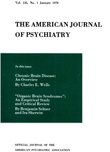DIAGNOSTIC ASPECTS OF A STUDY OF INTRACELLULAR PHOSPHORYLATIONS IN SCHIZOPHRENIA
Abstract
1. This test affords a means for study of intracellular biochemical changes.
2. Proceeding from the fact that it has given quite uniform results in a fairly large healthy control group of persons and that different results are obtained in the cases of some clinically psychotic patients, we may classify the test results of the first group as normal and of the second group as pathological.
3. The test gives normal response in the cases of most of our patients diagnosed clinically as suffering from psychiatric conditions other than schizophrenia as well as in diabetics and hyperthyroid cases.
4. Pathological test results are obtained chiefly within the schizophrenic range of diagnoses but some of the most clinically characteristic schizophrenics give normal results with this test.
5. Present indications are that there is some factor present within the group of schizophrenic spectrum cases which is common to many of these cases but that the central group of well confirmed, long-term cases of schizophrenia is itself not positively distinguishable by this means.
6. At the present state of the investigation the cases showing "normal type" enzymatic response can be tentatively characterized by the lack of the symptomatology of an acute psychotic attack of a sudden onset as it is typical in cases described as simple schizophrenia.
Access content
To read the fulltext, please use one of the options below to sign in or purchase access.- Personal login
- Institutional Login
- Sign in via OpenAthens
- Register for access
-
Please login/register if you wish to pair your device and check access availability.
Not a subscriber?
PsychiatryOnline subscription options offer access to the DSM-5 library, books, journals, CME, and patient resources. This all-in-one virtual library provides psychiatrists and mental health professionals with key resources for diagnosis, treatment, research, and professional development.
Need more help? PsychiatryOnline Customer Service may be reached by emailing [email protected] or by calling 800-368-5777 (in the U.S.) or 703-907-7322 (outside the U.S.).



